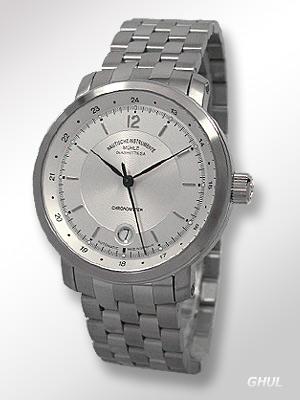Chronometer/en: Unterschied zwischen den Versionen
| (15 dazwischenliegende Versionen von 3 Benutzern werden nicht angezeigt) | |||
| Zeile 1: | Zeile 1: | ||
| − | + | [[Bild:TITAN-CHRONOMETER-M IV.jpg|thumb|[[Mühle Glashütte Titan-Chronometer-M IV|Mühle TITAN-CHRONOMETER-M IV]]<br>Referenz M1-99-21-MB]] | |
| − | + | A chronometer is a timekeeper precise enough to be used as a portable time standard, usually in order to determine longitude by means of celestial navigation. In the world of watches, the term is also often attached to those tested and certified to meet certain precision standards. In Switzerland, only timepieces certified by the [[COSC]] may use the word Chronometer on them. | |
| − | [[Bild: | ||
| − | [[ | ||
| − | A chronometer is a timekeeper precise enough to be used as a portable time standard, usually in order to determine longitude by means of celestial navigation. In the world of watches, the term is also often attached to those tested and certified to meet certain precision standards. In Switzerland, only timepieces certified by the COSC may use the word Chronometer on them. | ||
| + | |||
| + | == The Magnitude of the Problem == | ||
| + | Determining longitude remained the most persistent problem facing oceangoing vessels in the early modern world. | ||
| + | |||
| + | |||
| + | == Scientific Background == | ||
| + | Although the clock method would ultimately prove the winner, the logic of this was not at all apparent to many talented scientific and mathematical minds of the early modern era. Rival theories abounded. Among those offered were Galileo Galilei's (1564–1642) proposal of measuring and using the motions of Jupiter's four moons as celestial clocks, and comparing the times when these moons eclipsed one another with the same astronomical event at his local time. | ||
| + | |||
| + | == Observatory Chronometer == | ||
| + | In 2017 the Observatory Chronometer Database (OCD) went online, which contains all mechanical timepieces ("chronometres-mecaniques") certified as observatory chronometers by the observatory in Neuchatel from 1945 to 1967, due to a successful participation in the competition which resulted in the issuance of a "Bulletin de Marche". All database entries are submissions to the wristwatch category ("chronometres-bracelet") at the observatory competition. | ||
| + | |||
| + | == External Links == | ||
| + | * [http://www.observatory.watch Observatory Chronometer Database (OCD)] | ||
| + | |||
| + | == Gallery == | ||
| + | <gallery> | ||
| + | Bild:Marinechronometer GUB.jpg|[[Marine chronometer]] | ||
| + | Bild:Lange VEB mit Lange 100-aaWS.jpg|Chronometer [[movement]] | ||
| + | </gallery> | ||
[[Category:Glossary]] | [[Category:Glossary]] | ||
| + | |||
| + | |||
| + | [[de:Chronometer/de]] | ||
| + | [[en:Chronometer/en]] | ||
| + | [[es:Cronómetro/es]] | ||
| + | [[fr:Chronomètre/fr]] | ||
| + | [[it:Cronometro/it]] | ||
| + | [[nl:Chronometer/nl]] | ||
| + | [[sv:Kronometer/sv]] | ||
| + | [[ru:Хронометр]] | ||
Aktuelle Version vom 27. Oktober 2017, 14:14 Uhr
A chronometer is a timekeeper precise enough to be used as a portable time standard, usually in order to determine longitude by means of celestial navigation. In the world of watches, the term is also often attached to those tested and certified to meet certain precision standards. In Switzerland, only timepieces certified by the COSC may use the word Chronometer on them.
The Magnitude of the Problem
Determining longitude remained the most persistent problem facing oceangoing vessels in the early modern world.
Scientific Background
Although the clock method would ultimately prove the winner, the logic of this was not at all apparent to many talented scientific and mathematical minds of the early modern era. Rival theories abounded. Among those offered were Galileo Galilei's (1564–1642) proposal of measuring and using the motions of Jupiter's four moons as celestial clocks, and comparing the times when these moons eclipsed one another with the same astronomical event at his local time.
Observatory Chronometer
In 2017 the Observatory Chronometer Database (OCD) went online, which contains all mechanical timepieces ("chronometres-mecaniques") certified as observatory chronometers by the observatory in Neuchatel from 1945 to 1967, due to a successful participation in the competition which resulted in the issuance of a "Bulletin de Marche". All database entries are submissions to the wristwatch category ("chronometres-bracelet") at the observatory competition.
External Links
Gallery
Chronometer movement


